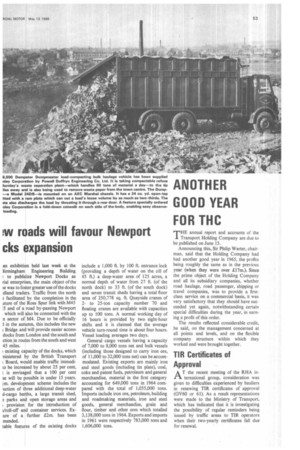w roads will favour Newport cks expansion
Page 55

If you've noticed an error in this article please click here to report it so we can fix it.
an exhibition held last week at the lirmingharn Engineering Building to publicize Newport Docks as rial enterprises, the main object of the ie was to foster greater use of the docks dland traders. Traffic from the north .t facilitated by the completion in the ature of the Ross Spur link with M45 :5 and of a road by-passing Newport which will also be connected with the n sector of M4. Due to be officially in the autumn, this includes the new t Bridge and Will provide easier access docks from London and the south and etion in routes from the south and west 45 miles.
existing capacity of the docks, which ninistered by the British Transport ; Board, would enable traffic immedito be increased by about 25 per cent, t is envisaged that a 100 per cent se will be possible in under 15 years.
development scheme includes the uction of three additional deep-water Li-cargo berths, a large transit shed, 5 parks and open storage areas and
provision for the introduction of ilroll-off and container services. Exure of a further £2m. has been mended.
table features of the existing docks include a 1.000 ft. by 100 ft. entrance lock (providing a depth of water on the cill of 45 ft.) a deep-water area of 125 acres, a normal depth of water from 27 ft. (of the north dock) to 33 ft. (of the south dock) and seven transit sheds having a total floor area of 250,778 sq. ft. Quayside cranes of 2to 25-ton capacity number 70 and floating cranes are available with capacities up to 100 tons. A normal working day of 16 hours is provided by two eight-hour shifts and it is claimed that the average vehicle turn-round time is about four hours. Vessel loading averages two days.
General • cargo vessels having a capacity of 7,000 to 8,000 tons net and bulk vessels (including those designed to carry iron ore, of 11,000 to 32,000 tons net) can be accommodated. Existing exports are mainly iron and steel goods (including tin plate), coal, coke and patent fuels, petroleum and general merchandise, material in the first category accounting for 649,000 tons in 1964 compared with the total of 1,055,000 tons. Imports include iron ore, petroleum, building and roadmaking materials, iron and steel goods, general merchandise, grain and flour, timber and other ores which totalled 3,138,000 tons in 1964. Exports and imports in 1961 were respectively 783,000 tons and 1,606,000 tons.




















































































































































